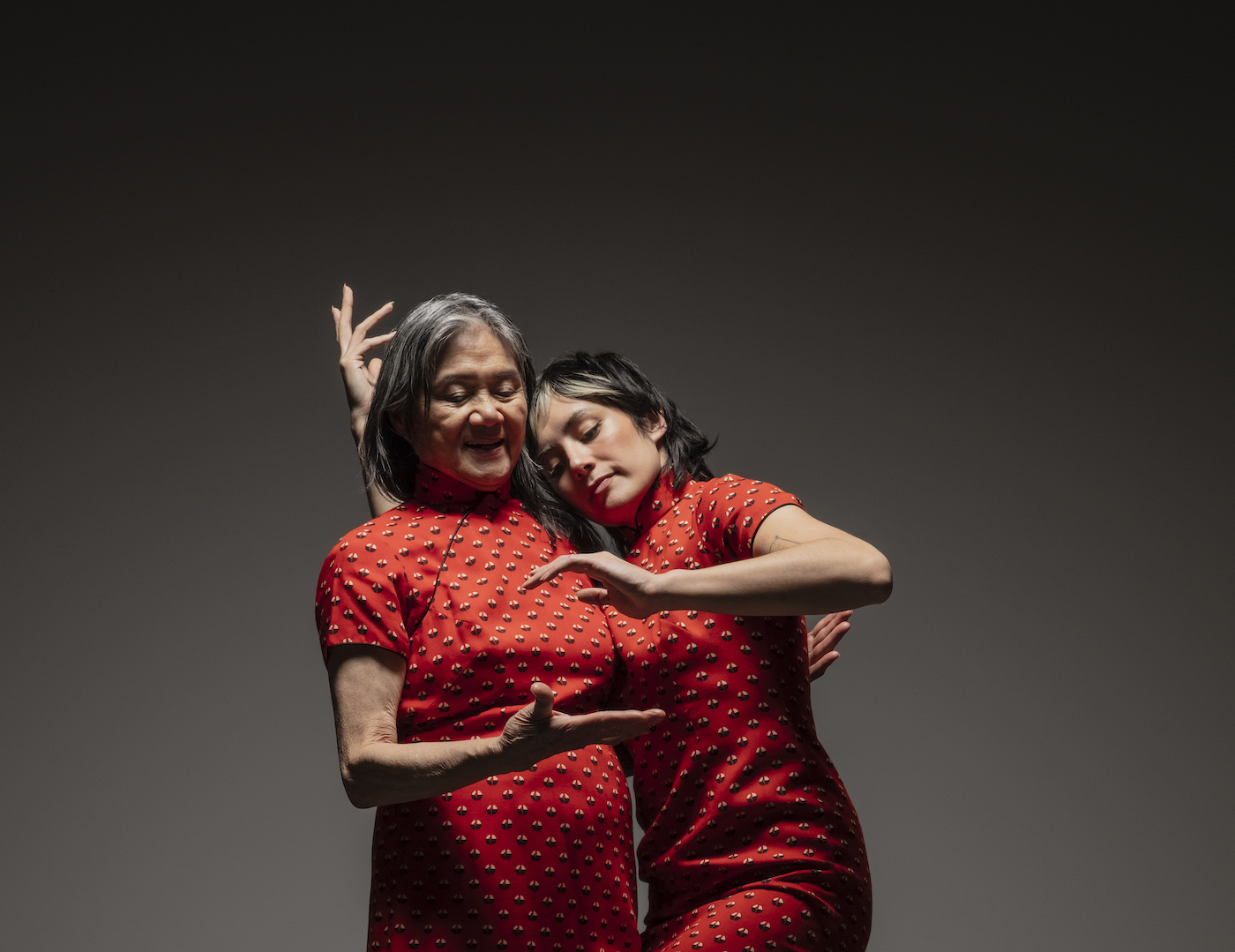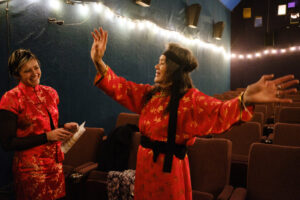
Photo by RJ Muna
[ID: Melissa, a mixed Asian person, leans their head on Joy’s shoulder, with a hand in front of Joy’s heart. Joy, an older Chinese woman, looks out with a slight smile, one hand palm up below Melissa’s, as if holding an invisible orb together. They wear matching red qipao dresses, a grey backdrop behind.]
Kim Ip and Kat Gorospe Cole are creative contributors for a new show by Melissa Lewis Wong, 花和霧 flowers and fog, made in collaboration with Melissa’s mother, Joy Chenyu Lewis. The performance is a kaleidoscope of dance, drag, Chinese traditional song and Broadway tunes, dumplings, tea and mahjong.
The article below is a response to Melissa’s work, capturing a moment in-process during its development. Excerpts are from a creative discussion Kat and Kim had with Melissa and Joy. Tea was being poured and small winter melon cakes were being served on a sunny afternoon in Melissa’s apartment.
Kat: I first experienced Melissa’s project during the midst of shelter in place, stranded in my tiny bedroom in North Berkeley. The absence of people was a weight I felt in my bones. Melissa’s film version of 花和霧 flowers and fog showed me a tender and powerful way of connecting with loved ones from a distance. While staying in Hawai’i, Melissa had remotely collaborated with their mother, Joy, who was in Massachusetts, to create a dance film about their relationship.
Joy is in her 70s. She is a warm, thoughtful and caring person. She loves singing (yes, you’ll hear her in the show). She sang at public protests in NYC in 1989 in response to the Tiananmen Square massacre on June 4, 1989, and the arrests and persecution that followed. She has sung at going away parties for coworkers, expressing the sadness that is unspoken. She diligently tends to her garden in Massachusetts and waters Melissa’s plants when she visits SF. She fed me (Kat) a dumpling by hand during a work-in-progress of this show.
Kim: Melissa is 31. She is a mild-spicy Sagittarius that somehow always makes time to sit and have tea. She is ⅙ of Asian Babe Gang, Hapa, Queer, humble, and really smart. She has been regularly attending protests for Palestine and recently finished collaborating with Rebecca Fitton and Detour. Throughout her busy days she is as cool as a cucumber. About three weeks back I (Kim) shared cheesy grits with Melissa and just yesterday, she offered to spoon-feed me grits
Kat: In this staged version of 花和霧 flowers and fog, Joy and Melissa share the stage, witnessing each other and asking the audience to witness them and their relationship. For me, this is an invitation to celebrate our multidimensionality and allow ourselves to be surprised by those who are closest to us.

[ID: Melissa smiles at Joy in the Little Roxie theater. They both wear red Chinese patterned outfits. Joy wears a black headband and gestures with both her arms extended upward, with a big smile on her face.]
Melissa: I think it’s an opportunity to meet each other in a new way and reimagine the connection…We did an open rehearsal showing at the Dresher residency in September. I remember feeling kind of like I saw my mom in a new way when she sang the Songhua River song. It was really powerful to see her…I hadn’t experienced Joy as an incredibly powerful and captivating performer, or [to Joy:] I just hadn’t had an opportunity to see you in that way. That was really special.
Kat: What would it be like to meet your parent again for the first time, after knowing a version of them for over three decades?
Kim: Lowkey been obsessed with what-if allegories since 2019. I think it’s tied up with the whimsical, mysterious phenomena of letting yourself be vulnerable to the fantasy of what if… What if your relationship with your mum was living in the “what-if”? Which brings me to the reference of Everything Everywhere All at Once, a cinematic masterpiece that puts a surrealist landscape as the meeting place for creating new parent-child relationships. We observe the daughter becoming a mega villain and the mum starting to show up as her vulnerable self rather than villainous opponent. And for a portion of the film, the mum isn’t sure she will share a world with her daughter until we are met with a scene where they drop into a canyon and the mum and daughter are next to each other as rocks, perhaps agreeing to be in each other’s presence.
Joy: The Chinese mother show up here and there and she [Melissa] appreciate my being Chinese, being somebody loves to sing. Once I was singing a song, Melissa and her Chinese dance teacher, they were dancing. [to Melissa:] I think that was when you were, I don’t know, eight years old. Do you remember?
Melissa: Yeah. And in a way you could view this experience, this show, as just another version of that many, many years later. I feel excited to create the show and give you space to be very powerful and be very loud and really enjoy it.
Kim: …and isn’t that what this is. A dance and storytelling performance where we as the audience get to experience you meeting many versions of your mum? Speaking from my own experience of my mother-daughter relationship, some of us don’t get to have that invitation to observe all that is present and all that is here in the passage of time. How beautiful it is to watch each other’s growth into community roles and then how that refracts back to each other–perhaps this is a metaphor for watching a tea ball unfurl! Utilising performance as the medium to reflect upon this ever-changing relationship between mother and daughter is so so so beautiful!
Kat: I find it really exciting to be part of this project with both Kim and Melissa because there’s a kinship I feel with all 3 of us Asian-Am, Queer artmakers in our 30s. Each of us has been compelled to process our relationship with our mothers through our art forms. Melissa’s film with her mother and Kim’s project interviewing elders (about sexiness and sensuality) both inspired me to tell my own personal story, and here we are now collaborating with Melissa and Joy for their show. It makes me wonder, what is it that’s drawing you both, Melissa and Kim, to this desire at this point in your life? For me, it’s been a way to connect to my mother’s culture and homeland, which I feel separate from, and to understand that grief.
Kim: I found myself really wanting to be friends with my mother and be a form of support or a place of nurturing for my mother, because that’s what I do for a lot of my friendships. I began teaching a weekly elders dance class that centered around joy, creativity, and belonging—this was my baby step towards safely getting closer to reimagining the potential friendship future I will have with my mum.

[ID: Joy wears long black hair, a grey shirt and red skirt. She helps toddler Melissa – with short brown hair, a white patterned shirt and puffy blue pants – keep her balance standing beneath a beige stoned Buddha sculpture twice Joy’s height – Melissa touches the sculpture’s foot. Joy looks at Melissa.]
Melissa: Perhaps we’re all in different versions of departures from our families of origin and then trying to figure out if/how to return. I see the way relationships can be marked by severing (moving away, misunderstanding, inability to hold space for one another, emotional volatility, layers of trauma, teenage angst, not knowing how to talk about mixedness, and so on). Somehow I’m finding myself at a place where I want to warmly hold what had been severed, or be curious about reframing it with my mom. Also, to be very candid, the first idea for the film and collaboration began in early COVID moments… I really couldn’t fathom losing my mom. Her health situation pointed to the likely possibility of serious complications; I wanted to know more; I didn’t want her to die. Sorry if that’s dramatic. But I was learning more than I’d ever heard about Joy’s struggle to have me at 42. Reckoning with how close I was to not existing, how fragile Joy’s health felt, how present my own questions about having a child were/are… These enormous life/death cycle questions about mortality! The closest thing I felt I could reach for was to make something. Transforming the fear into movement, visual images, and storytelling was comforting. It brewed the tea leaves into something we could sip on, together. And I don’t think that journey has ended!
Kim: [to Melissa:] It’s taken you 31 years. You know what I mean? It takes I think 31 years to then be like, mum, I want to, let’s try again. Yeah, let’s try it. Now that I have context and the ability to speak this and have other people or places to work through this, I am ready now to have this part of our relationship exist…You’re synthesizing your relationship through a show with many different experiences together, but you’re not telling us that the relationship is a fixed image. It changes a bunch of times.
Joy: Well, I have to thank you, Melissa, giving me the opportunity to do this. When I was in school, the professor said, ‘Why do you study this voice? What are you going to do? Why do you want music major?’ I said, ‘I don’t want to do anything. I just want to learn to sing.’ [The professor said], ‘That’s very hard to get a job.’ I said, ‘That’s fine. Why do I need a nine to five job? No, not for me.’
Melissa: I’m genuinely grateful to Joy for her unwavering trust in expression with this project and throughout my life. I have absolutely inherited it in my own worldview and life path, thanks to her.
Eric [Garcia] and I were also thinking about what the goal of 花和霧 flowers and fog is: why is it existing, what’s the goal for the audience? For Joy and I, I think it’s a playful expression or self-portrait, a strange and fantastical experience of parent and child, and an experience where there’s space to interact with and receive these different dimensions of us—but also not omitting the complexity, rupture or challenges. For me, working with Joy often feels like looking into a strange/special mirror—seeing the parts of me that are similar, different, changing between us; and I truly hope that’s a gift we can offer to audiences who come to witness us.
花和霧 flowers and fog premieres May 17-26 at the Gateway Theater in San Francisco. Info and tickets at melissalewis.art
Kat Gorospe Cole creates subtlety and spectacle through film, performance and drag. They revel in queer frivolity and immersive theater with Detour, which they’ve co-directed with Eric Garcia for 15 years. katcole.works
Kim Ip choreographs, directs, produces, and dramaturgically supports the creation of dance works, drag performances, and video. She is ⅙ of ABG (Asian Babe Gang) and loves poetry as much as she loves to be entertained. krimmip.com



